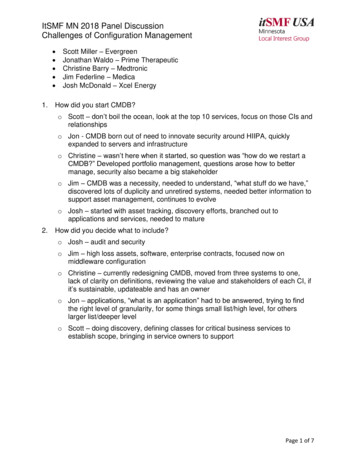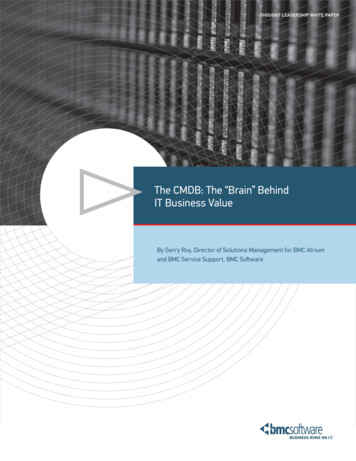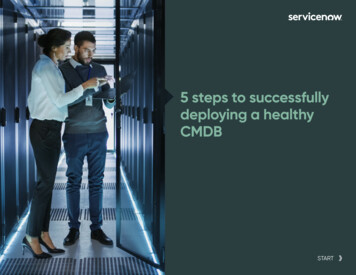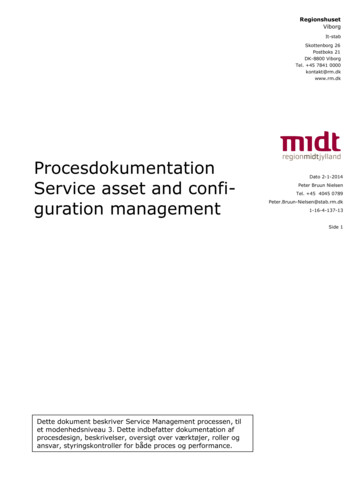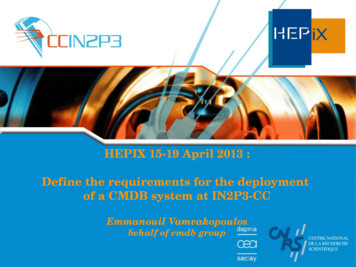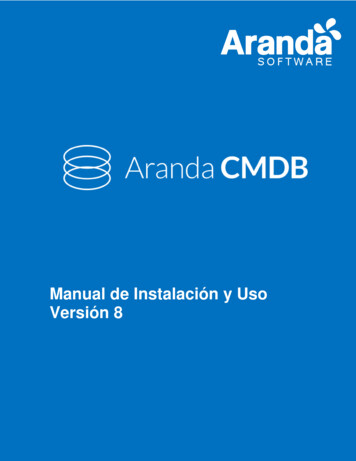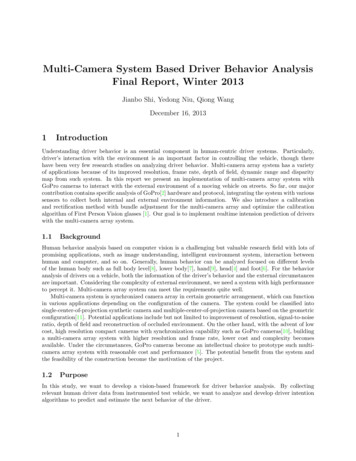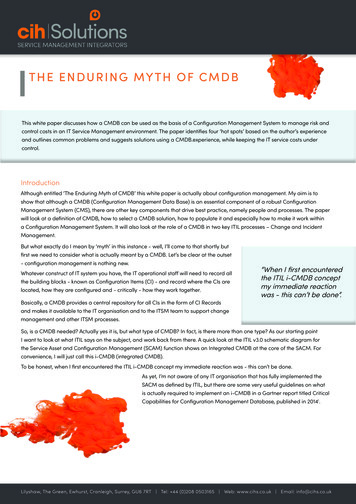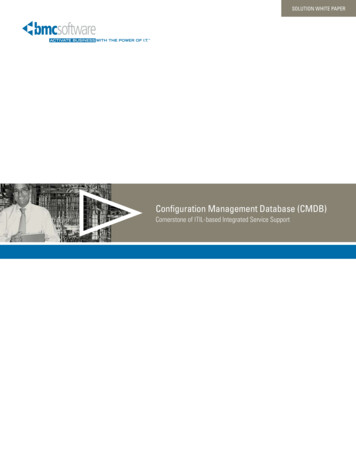
Transcription
SOLUTION WHITE PAPERConfiguration Management Database (CMDB)Cornerstone of ITIL-based Integrated Service Support
Table of ContentsABSTRACT . 1INTRODUCTION . 2CORNERSTONE OF SERVICE SUPPORT .2SOLUTIONS THAT ENABLE THE CORNERSTONE .5BUSINESS SERVICE MANAGEMENT . 6CONCLUSION . 7
AbstractThe IT Infrastructure Library (ITIL ) is the standard for industry best practices for IT Service Management, which includes Service Support and Service Delivery. Service Support is the referencebook most commonly used within the IT industry. Service Support, as defined by ITIL, has sixmain elements: The Service Desk Incident Management Problem Management Change Management Configuration Management Release ManagementEach of these six elements integrates with and depends upon the other. Often, integration of applications simply means passing key data from one database into another to ensure the correct informationis available to the management process. This exchange creates issues related to duplication and ownership of data. Typically, the solution has been to consolidate this data together into a single database,shared by all relevant service applications, as dictated by a particular process.A better method is to create a single view accessible by all users, thus ensuring that data ownersremain data owners, protecting the existing investment in service support applications by enabling inte1gration in a federated manner. This is the idea behind a configuration management database (CMDB).The term cornerstone can be defined as:1. A stone that forms the base of a corner of a building, joining two walls2. A vital part or basis: sugar was the cornerstone of the economyWhichever definition you prefer, the idea is the same — without the cornerstone, any structure eventually crumbles or fails. The cornerstone concept aptly describes the CMDB within any IT servicemanagement solution.This paper discusses the function, benefits, and importance of a CMDB and why it has become thecornerstone of IT service support. Business Service Management (BSM), the BMC Software strategyof managing IT from a business perspective, will also be reviewed in conjunction with the award-winning BMC AtriumTM solution.1The term “ federated” is defined as “a state comprised of a number of self-governing regions or functions united by a central (federal) system.”PA G E 1
The key phrases here are relevant details and important re-Introductionlationships. Relevant detail refer to the attributes and fieldsA common theme throughout ITIL is the need for a cen-allocated for each CI type. This requires careful planningtralized view of IT Service Management data—essential todelivering consistent, reliable, effective, and efficient serviceto the business customers. This centralized view is referredto as the configuration management database (CMDB).when designing the CMDB. For a better chance of success, consider the requirements of other ITIL processeswhen assigning attributes (refer to CMDB Utilization inTable 1 of this paper). Important relationships is a criticalfactor because it is these relationships that differentiateAdhering to ITIL guidelines, Configuration Managementthe CMDB from a simple database, one that contains amust:list of items and their attributes (e.g., an inventory or as- Account for all the IT assets and configurations withinset database).the organization and its servicesBeing able to identify and display relationships makes the Provide accurate information about configurations andtheir documentation in order to support all other ServiceCMDB a decision and risk-analysis resource. For exam-Management processesple, if a server should fail, the service desk can instantlyidentify which customers and services are affected by the Provide a sound basis for Incident Management,Problem Management, Change Management andfailure. Or, a manager can check the potential effect of aRelease Managementchange before authorizing the submission of a Request forChange (RFC). Verify the configuration records against the infrastructure, and correct any exceptionsThe configuration item (CI) referred to in the CMDB definition above is a component of the CMDB, described byThe CMDB is the cornerstone of Service ManagementITIL as:whether or not you adopt ITIL standards. When you do a component of an infrastructure thatnot know what infrastructure items you have, wherethey are, how they are related, their current status andis (or is to be) under the control of Configurationtheir full history, you cannot effectively manage your ITManagement. CIs may vary widely in complexity, size,infrastructure. For example, during the Y2K crisis, someand type, from an entire system to a single module.estimates claimed that as much as 70 percent of revenuewas spent locating infrastructure asset items and only 30Throughout the lifecycle of a configuration item (CI), all as-percent was spent on the necessary technology updates.sociated activity must also be maintained within the CMDB,creating an audit trail of actions, incidents, problems, andToday, just five years past Y2K, many organizations arechanges made to that CI. This is vital to understanding whatagain struggling to identify their infrastructure items inis occurring to the CIs and provides the necessary detailsorder to comply with governance requirements detailedfor problem resolution, change-risk assessment, and total-by Sarbanes-Oxley (Sarbox) or Basel II regulations. Withcost-of-ownership awareness.an accurate CMDB and a good Change Managementpolicy, meeting the requirements of Sarbox or Basel IITable 1 (page 3) shows some of the key servies that thecan be accomplished faster and cheaper. Both are aboutCMDB can provide to other ITIL processes. To keep themanaging operational risk, which, from an IT perspective,table within sensible proportions, only five services arecan only be done by understanding the IT infrastructureshown for each ITIL process or function, whereas in re-and adhering to the ITIL processes to avoid disruption toality there are many more potential and actual servicesthe IT services that in turn directly affect vital businessprovided by having a comprehensive and accurate CMDB.functions (VBFs) and the underpinning data.Further, Table 1 shows how cross-functional processCornerstone of Service Supportintegration creates significant advantages for Service Management. Notice that most ITIL proponents start theirMost of the information an organization needs to successfully adhere to ITIL guidelines can be housed witha CMDB. ITIL briefly describes a CMDB as:“A database that contains all relevantdetails of each Configuration Item (CI) and detailsof the important relationships betweenimplementations with a CMDB. The most important personto a football team, for example, is the coach because onlythe coach can see the entire picture and give the best instruction at the best time. The CMDB is similar becauseit provides a complete view of a CI, enabling all other processes to work cohesively as one.Configuration Items.”PA G E 2
Service SupportService DeliveryIncident Management Automatically populates records Provides status of configuration items Provides urgency data for priorities Provides impact data for priorities Provides escalation dataService Level Management All SLA components must be in CMDB SLAs can be referenced from CMDB Provides reference point for underpinning contracts Shows customer ownership CMDB is a vital component for the Service Improvement ProgramProblem Management Automatically populates problem records Provides status of configuration items Provides risk analysis data for priorities Provides ownership data Provides data for proactive problem analysisCapacity Management Each CI is a potential Capacity Management candidate CMDB provides resources for capacity modelling Shows related CIs in a capacity grouping Provides vital risk-analysis data CMDB reduces time-solving capacity related to incidents and problemsChange Management Shows CIs that are in the Change Management process Provides risk-analysis data Shows which other components could be affected by a change Provides feedback data about customers for changes Reflects the new status immediately after a changeAvailability Management Provides vital business impact data Availability Management is to be applied to all CIs in CMDB Shows related components in an Availability string Provides risk-analysis data Helps to isolate which CIs are the root cause of availability failuresRelease Management Tracks rollout status Keeps version details for software Enables planning vital data for rollouts Provides feedback data about customers for rollouts Provides data for financial impact of ReleasesFinancial Management Shows which CIs are used for each service provided to the customers Provides chargeback components Provides important governance information Provides a vital source for inventory and asset audit Important tool for financial calculations (e.g., budgeting and forecasting)Service Desk Identifies CMDB errors Uses CMDB to record incidents Provides proactive notification to the users Provides feedback to customers about CMDB changes Assists Configuration Management with CMDB auditContinuity Management Baselines provide vital recovery data Changes in CI status could mean changes in Continuity requirements Identifies any potential continuity outages Provides feedback data to customers during outages Shows status of CIs as they become active after an outageTable 1. Configuration Management Database UtilizationThe strength of ITIL does not come from just a set of5. Problem Management identifies the root cause and aprocesses and functions, but from the processes incorporating cross-functional integration. The relationship betweensolution for the root cause.6. Problem Management creates and submits an RFC toIncident, Problem, Change and Release Management illustrates this point very well:implement the solution.7. The change is accepted and is processed through the1. The Service Desk solves an issue for a customerChange Management process.and completes an incident record. (The original inci-8. Change Management may forward the RFC to Releasedent may have been raised by another ITIL element,Management for the deployment of the change acrosssuch as Event Management, part of Infrastructurethe infrastructure, matching the RFC criteria.Communications and Technology Infrastructure9. Incident and Problem Management are notified whenManagement.)the change is successfully implemented.2. Incident Management notifies Problem Management,10. Incident Management ensures that no new incidentswhere a problem record is opened or an existing prob-appear because of the change.lem record is updated.3. Problem Management creates a work-around and noti-The more integrated these processes are the better thefies Incident Management for any further recurrenceslevel of service to the customer (when processes areof the incident.automated, service levels improve greatly). The cross-func-4. Problem Management includes the work-around fortional integration is not just linear; there is a bidirectionalthe known error database for reference by all theflow between the processes. In fact, one of the mainService Support functions.measures for ITIL process maturity is the amount ofPA G E 3
cross-functional integration that exists between the ITILFor example, you can implement Incident Managementprocesses and the business processes, as illustrated inwithout a CMDB, but how would you automatically popu-Table 2.late incident records? How would you identify a prioritywithout knowing the impact and urgency of the incident?How would you become proactive and notify customersLevelFunctionAbsenceThere is absolutely no evidence of anyactivities supporting the process.affected by an incident? A CMDB not only provides the0InitiationThere are ad-hoc activities present, butwe are not aware of how they relate toeach other within a single process.also perform all of these activities dynamically.1CMDB — but to gain maximum advantage, a CMDB isAwarenessWe are aware of the process, but someactivities are still incomplete or inconsistent; there is no overall measuring ndata for these activities, but with quality technology canOf course, you can get system-led benefits without acritical. The following list provides ten key benefits forimplementing ITIL Service Management.The process is well understood andimplemented as a single process, but isnot integrated with other processes.1. Improved quality of service and more reliable businesssupport – How can you improve the quality of service ifyou do not have the components of that service clearlyThe process is now managed by incorporating financial management, forwardscheduling, trend analysis, and businessrelationships and is integrated with otherIT systems and service processes.defined? A CMDB provides the configuration for eachservice and the resulting foundation for improving thequality of service.2. IT service continuity procedures provide more focus,The process is fully integrated with business processes to provide a platform forstrategic executives to make reliable business decisions using the power of theirtechnology resources.more confidence in the ability to follow them whenrequired – Imagine if a remote office of 200 workstations burned down. How would you know thetechnology that was in that office and how it was configured? Without that information, how could the officeTable 2. Generic Capability Maturity Modeling (CMM)be rebuilt or reinstated? A CMDB provides both thetechnology details and the configuration details forIn Table 2, notice how Levels 3, 4, and 5 all show in-all locations. That information can be available with-creased degrees of integration. It is also important toin seconds and provides an immediate blueprint forkeep in mind that to achieve Business Service Manage-reconstruction.ment (BSM), the ITIL processes and the business3. Clearer view of current IT capability – To be able toprocesses must be integrated and that the CMDB playsprovide a clear view of IT capability you must knowa vital role in that integration.the status of the entire IT infrastructure. One of theroles of the CMDB is to maintain the status of all in-For example, in IT reports, a gasoline pump that acceptsfrastructure items, CIs, which have upcoming changes.credit cards is just another terminal and probably identified4. Better information about current services (and possiblyto IT by its model type; to the business owners, however,the pump is a revenue-generating opportunity and is likelyabout changes that would bring additional benefits) –known by a more functional name. Business managersWithin each CMDB, each CI should have an attribute,need reports and information using the functional namesor attributes, describing which service, or services, tofor devices (e.g., gas pump), rather than IT device nameswhich it relates.that they do not understand. This is where the CMDB can5. Greater flexibility for the business through improvedcontribute some cross-functional integration with the busi-understanding of IT support – By having control ofness. For example, the CI for the device could contain twoyour resources, the more information you have theattributes—one with the IT name for the device (12 xyzabcmore flexible you can be. If you know all of the com-devices failed yesterday) and the other with the businessponents that need to be considered for a potentialname (12 gas pumps failed yesterday).change then you can ensure that those items meetthe requirements of a change when it is implemented.The CMDB is vital for cross-functional integration and isFor example, you may need to update your browser toalso a vital resource for ensuring the successful implemen-meet changing needs. This is one of the reasons whytation of ITIL Service Management. Of course, you can stillthe relationships within the CMDB are so important.implement some of ITIL and achieve a reasonable level ofOnce you know what component you are going tosuccess without a CMDB, but the key word is “reasonable.”change, the CMDB will show you all of the relatedPA G E 4
components. You can then review the related compo-changed to ensure a harmonious environment goingnents to identify whether they will need any changesforward. When upgrading to a software component,to ensure that they will function with the componentall software-recipient browsers may need to be onthat is to be changed.the most current release before the upgrades can be6. Increased staff motivation and improved job satisfac-made. With a CMDB in place, you will know whichtion through better understanding of capability andusers are to receive the software upgrade and theirbetter management of expectations – Despite popu-browser version. Without a CMDB in place, you loselar misconceptions, most people prefer working in acycle time identifying this information, and have astructured, organized and orderly environment. It ishigher chance of failure because the older browserreassuring to know that virtually no changes will failversions were not properly discovered.or create new incidents, so that the service deskSolutions that Enablethe Cornerstonestaff can concentrate on the customer needs, ratherthan be distracted by entering incident ticket data.In addition, managers will be in a better position toOver the years many organizations have attempted to cre-understand the needs of their staff. The CMDB pro-ate a CMDB; however, most have failed, simply becausevides a basis for accurate and readily available datathey tried to populate a single physical database with allthat will contribute greatly to motivated staff andthe information from various related services within IT. Nothigher levels of job satisfaction.only was duplication inevitable and data ownership difficult,7. Enhanced customer satisfaction as service providersbut IT services were also encumbered with surplus data,know and deliver what is expected of them – Themost of which was needed by only a few functions andCMDB provides the knowledge, while the rest ofnot the entire service.ITIL provides the delivery. However, delivery withoutknowledge is doomed to failure.Recognizing this issue and the absolute need for a CMDB8. Increased flexibility and adaptability is likely to existin the delivery of IT services aligned with ITIL, BMC createdwithin the services – Great golfers, such as Tigerthe BMC Atrium CMDB. This is a federated CMDB linkingWoods, do not play a championship tournament with-the core-services data into a common single view of theout first having played the golf course while theircommon cross-service data. BMC Atrium provides a 360-caddies measure yardages and disseminate the haz-degree view of the CIs, from any IT service perspective.ards. Equipped with that knowledge, golfers can beadaptable to the demands of the tournament.Figure 1 clearly shows that the automated population of9. System-led benefits such as improvements in secu-the CMDB is through integration with the BMC Discoveryrity, accuracy, speed, and availability as required toSuite or with any acquired and deployed data collectionmeet the service levels – To improve a system youtools, thus protecting your existing investment in technol-need to know all of the components of that systemogy. Based on predetermined rules, the unique (patented)and where they are located. In a CMDB, the neces-Reconciliation Engine ensures that CI duplicates are re-sary components are easily found under the guisemoved and any extra data collected by one tool, and notof CIs.another, are uniquely merged to provide a full picture of10. Improved cycle time for changes and greater successrate – Many changes require other components to bethe configuration of the CIs. Links are then made to external databases such as enterprise resource planning (ERP)Remedy AssetManagementRemedyHelp DeskRemedy ChangeManagementLife Cycle (schedules, POs)ContactsCostsIncidentsProblemsTasksChange RequestsTasksWork OrdersRemedy Service SLAsLevel Agreement Measurement RecordsRemedy ImpactManagementFigure 1. BMC Atrium CMDB and application dataPA G E 5Service ImpactEvent Correlation
Business/ITManagerAtrium ViewAtrium ReportingServiceLevelManagementIncident andProblemManagementInfrastructureand ApplicationManagementService Impactand EventManagementAssetManagementand DiscoveryChange andConfigurationManagementCapacityManagementand ProvisioningIdentityManagementBMC Atrium CMDBFigure 2. Need for Web services and data integrationtools (SAP or Seibel, for example) and active directories,By viewing IT management through a business serviceswhich also hold required data.lens, BMC Software has developed a plan for integratingall of its management disciplines into a cohesive strategyFinally, this reconciled data is made available to, and fedthat allows IT and business services to be managed to-from, the IT services applications covering such tasks asgether. This new approach is a response to both customerIncident and Problem Management, Change Management,and industry analyst feedback. Both have noted that thereRelease Management, and Service Impact Managementis a movement toward a business-centric view of IT. Thiswithin the core Service Support functions. The BMC Atriumis not a divergence from past initiatives. BSM is the logicalCMDB can be integrated to Event Management for ICTevolution of the BMC Software management strategy andInfrastructure Management processes and so on, to be-builds on the solutions that BMC Software has deliveredcome the single source of data for all the ITIL process.over the past 20 years, extending the promise of AssuringBusiness Availability. It is built around three essential com-The CMDB in conjunction with Atrium Reporting andponents that are critical to achieving BSM: Service ImpactAtrium View combines a reporting facility and viewingManagement, IT Service and Applications Managementmechanism (see Figure 2) from an IT perspective and aand IT Operations and Infrastructure Management.business process perspective, highlighting the vital business functions (VBFs). This viewing mechanism providesFigure 3 (page 7) shows the BSM model, with the focus ata graphical interpretation of how the IT infrastructure isthe top on the Business operations, objectives and VBFs,performing, and which VBFs are at risk, with a drill-downintegrating all the IT services functions to enable a holisticfacility to check on actions being carried out to preventview of the services being delivery from a business per-or reduce outages. This enables the IT infrastructure tospective. The CMDB is at the core of those IT services,be managed from a business perspective and deliverfeeding and being fed by all the relevant IT functions nec-true Business Service Management.essary to manage the IT infrastructure. BMC Software iscommitted to ensuring that this model is underpinned byBusiness ServiceManagementthe ITIL set of best practice processes and has both theService Desk and the IT Service Management suite applications all verified by the PinkVerifyTM program. This meansActivate Business with the power of IT and move from cri-that it has been objectively assessed according to the cri-sis management to value delivery with Business Serviceteria specified by ITIL guidelines and certified by a qualifiedManagement. The key to BSM is rapidly aligning IT resour-Pink Elephant IT Service Management consultant as meet-ces and processes to directly support your most criticaling requirements to support the ITIL framework.business objectives ensuring the stability of your vitalbusiness functions.PA G E 6
Quality ofServiceBSM is a dynamicmethod for aligning ITto the business, and forensuring that IT is ableto support this goalsQuality ofExperienceTransactionsBusinessUserUnderpinned with bestpractices, the InformationTechnology InfrastructureLibrary (ITIL)Service LevelManagementService agementMobileStorageBatch and Online ApplicationsPerformance and ameand DistributedServers The Business Perspective ICT, Infrastructure Support Service Support- Incident- Problem- Change- Configuration- Release Service Delivery- Capacity- Availability- Financial- Continunity- Service Level Software Asset ManagementFigure 3. Business Service Management modelThe CMDB is “A database that contains all relevant detailsConclusionof each Configuration Item and details of the importantThe question is no longer whether to align IT with therelationships between Configuration Items.” It need not bebusiness — it is how. BMC Software offers proven waysa single repository, but may be a federation of the sourceto accelerate IT-business alignment and realize near-termreturn on investment (ROI) based on experience imple-data to ensure the appropriate data owners own the dataeven though it is available to all IT services and functions.menting more BSM solutions than any other company inthe industry. To enable clients to move toward BSM inThe CMDB is vital to providing all the relevant informa-manageable steps, BMC Software designed Routes totion to the IT functions and allows that 360-degree viewValueTM. The Routes to Value are the integration of manyof the Configuration Items, regardless of which IT serviceITIL processes broken down into complementary, instantlyaccesses it.beneficial functions.The CMDB is the facilitator in aligning IT with the business.The Routes to Value consist of:The CMDB will not only hold the information pertaining to Incident and Problem Managementthe CIs, but it will enable the mapping of business services Change and Configuration Managementto those CIs, making it possible to manage and protect the Service Impact and Event Managementvital business functions critical to the success of businesscontinuity and revenues. Service Level Management Infrastructure and Applications ManagementFinally, the CMDB is at the cornerstone of IT service man- Asset Management and Discoveryagement, by facilitating IT and business alignment and, Capacity Management and Provisioningtherefore, Business Service Management. For more infor- Identity Managementmation about BMC Software solutions that support ITIL,please visit www.bmc.com/itil.All of these Routes to Value are provided with and integrate into the BMC Atrium CMDB, ensuring from the startof the journey that the information is shared and the investment is protected.In summary, a CMDB will enable successful ITIL implementation and provide the basis for information sharing tofacilitate cross-functional process integration.PA G E 7
About BMC SoftwareBMC Software helps IT organizations drive greater business value through better management of technology. Our industry-leading BusinessService Management solutions ensure that everything IT does is prioritized according to business impact, so IT can proactively address business requirements to lower costs, drive revenue and mitigate risk. BMC solutions share BMC Atrium technologies to enable IT to manageacross the complexity of diverse systems and processes — from mainframe to distributed, databases to applications, service to security.Founded in 1980, BMC has offices worldwide and fiscal 2004 revenues of more than 1.4 billion. BMC Software. Activate your business withthe power of IT. For more information, visit www.bmc.com.BMC Software, the BMC Software logos and all other BMC Software product or service names are registered trademarks or trademarks of BMC Software, Inc.All other registered trademarks or trademarks belong to their respective companies. 2005 BMC Software, Inc. All rights reserved. 57429
tually crumbles or fails. The cornerstone concept aptly describes the CMDB within any IT service management solution. This paper discusses the function, benefits, and importance of a CMDB and why it has become the cornerstone of IT service support. Business Service Management (BSM), the BMC Software strategy

